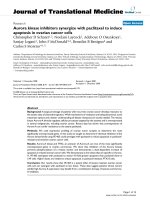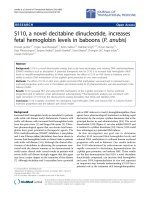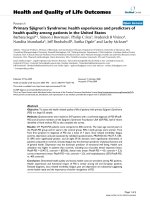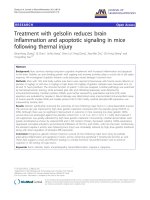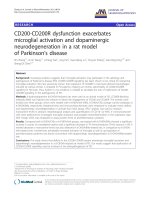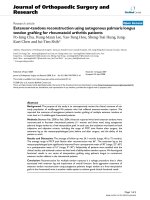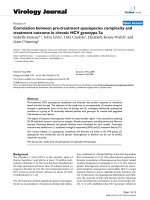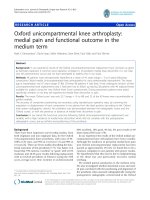Báo cáo hóa học: " Colistin: recent data on pharmacodynamics properties and clinical efficacy in critically ill patients" pot
Bạn đang xem bản rút gọn của tài liệu. Xem và tải ngay bản đầy đủ của tài liệu tại đây (204.42 KB, 6 trang )
REVIEW Open Access
Colistin: recent data on pharmacodynamics
properties and clinical efficacy in critically ill
patients
Argyris S Michalopoulos
1,2
and Matthew E Falagas
2,3,4*
Abstract
Recent clinical studies performed in a large number of patients showed that colistin “forgotten” for several decades
revived for the management of infections due to multidrug-resistant (MDR) Gram-negative bacteria (GNB) and had
acceptable effectiveness and considerably less toxicity than that reported in older publications. Colistin is a rapidly
bactericidal antimicrobial agent that possesses a significant postantibiotic effect against MDR Gram-negative
pathogens, such as Pseudomonas aeruginosa, Acinetobacter baumannii, and Klebsiella pneumoniae. The optimal
colistin dosing regimen against MDR GNB is still unknown in the intensive care unit (ICU) setting. A better
understanding of the pharmacokinetic-pharmacodynamic relationship of colistin is urgently needed to determine
the optimal dosing regimen. Although pharmacokinetic and pharmacodynamic data in ICU patients are scarce,
recent evidence shows that the pharmacokinetics/pharmacodynamics of colistimethate sodium and colistin in
critically ill patients differ from those previously found in other groups, such as cystic fibrosis patients. The AUC:MIC
ratio has been found to be the parameter best associated with colistin efficacy. To maximize the AUC:MIC ratio,
higher doses of colistimethate sodium and alterations in the dosing intervals may be warranted in the ICU setting.
In addition, the development of colistin resistance has been linked to inadequate colistin dosing. This enforces the
importance of colistin dose optimization in critical ly ill patients. Although higher colistin doses seem to be
beneficial, the lack of colistin pharmacokinetic-pharmacodynamic data results in difficulty for the optimization of
daily colistin dose. In conclusion, although colistin seems to be a very reliable alternative for the management of
life-threatening nosocomial infections due to MDR GNB, it should be emphasized that there is a lack of guidelines
regarding the ideal management of these infections and the appropriate colistin doses in critically ill patients with
and without multiple organ failure.
Colistin’s pharmacodynamic properties
Colistimethate sodium (CMS) is an inactive prodrug of
colistin that exhibits a low level of protein binding. It is
not stable in vitro and in vivo and is hydrolyzed in
human plasma, creating a complex mixture of partially
sulphomethylated derivatives with the potential to pro-
duce up to 32 different products, including colistin [1].
After administration of CMS, colistin appear s in plasma
rapidly. Colistin is approximately 50% bo und to hum an
plasma. Peak se rum levels after intravenous (i.v.) admin-
istration are achiev ed within 10 min. They appeared
higher but declined more rapidly than those achieved
after i.m. administration [2].
Colistin (base) is more active than CMS. Serum half-
life of CMS is approximately 1.5-2 hours (h) after i.v.
administration and 2.75 to 3 h after i.m. administration
in healthy subjects, whereas serum half-life for CMS
administered i.v. is more than 4 h. Old reports have sug-
gested that colistin is poorly distributed to the pleural
cavity, lung parenchyma, bones, and cerebrospinal fluid
(CSF) (15% to 25%).
CMS is eliminated predominantly by the kidneys. It
should be noted that after CMS i.v. administration,
approximately 60% of CMS is excreted unchanged in
the urine via glomerular filtration during the first 24 h.
In renal failure, the renal excretion of CMS is decrea sed
resulting in a higher conversion to colistin and
* Correspondence:
2
Alfa Institute of Biomedical Sciences (AIBS), 9 Neapoleos Street, 151 23
Marousi, Greece
Full list of author information is available at the end of the article
Michalopoulos and Falagas Annals of Intensive Care 2011, 1:30
/>© 2011 Michalopoulos and Falagas; licensee Springer. This is an Open Access article distributed under the terms of the Creative
Commons Attribution License ( which permits unrestricted use, distribution, and
reproduction in any medium, provided the original work is properly cited.
prolongation of half-life [3]. On the contrary, colistin is
eliminated predominantl y by the nonrenal route by
means of mechanisms not yet fully understood [4].
However, in humans, colistin is not absorbed from the
gastrointestinal tract and no biliary excretion has been
reported.
The pharmacodynamic (PD) properties of colistin,
such as minimal inhibitory concentration (MIC), muta-
tion prevention concentration, population analysis pro-
file, bacterial-killing kinetics, and the postantibiotic
effect (PAE) against multidrug-resistant (MDR) Gram-
negative bacteria (GNB), such as Pseudomonas aerugi-
nosa, Acinetobacter baumannii,andKlebsiella pneumo-
niae, have been examined in recent studies [5,6]. Based
on the study by Owen et al. [5] colistin seems to be
very active in the initial killing of A. baumannii,even
with 0.5 × MIC, exhibiting a concentration-d ependent
bacterial-killing mechanism. Modest positive PAEs of
colistin were observed at relatively high concentrations
(≥16 × MIC), which are not achieved in clinical practice.
The most significant finding of the study was the sub-
stantial regrowth occurring at 24 h even at colistin con-
centrations up to 64 × MIC and the minor or negative
PAE of colistin [7]. These findings were consistent with
the hetero-resistance of A. baumannii isolates to colis-
tin, reported in previous studies, suggesting that CMS
monotherapy and extended-interval dosage regimens
may be problematic for the effective treatment of noso-
comial infections caused by colistin-heteroresistant A.
baumannii in the intensive care unit (ICU) setting [7].
Poudyal et al. [6] found initial rapid killing against K.
pneumoniae strains even at the lowest colistin concen-
tration. Similarly with the previous study dealing with
the colistin pharmacodynamics against MDR A. bau-
mannii, colistin exhibited no PAE at up to 64 × MIC,
regrowth in the majority of isolates at 4 h and hetero-
resistance to colistin in MDR but colistin-s usceptible K.
pneumoniae strains. These findings suggest that CMS
monotherapy and extended-interval dosage regimens, as
has been aforementioned for A. baumannii isolates, may
promote colistin resistance in MDR K. pneumoniae
strains
Colistin’s pharmacokinetic properties
The main pharmacokinetics (PK) of colistin are pre-
sented in Table 1. Few studies have addressed the PKs
of CMS and colistin in humans, especially in the ICU
setting. It should be emphasized that significant phar-
macodynamic parameters, such as Cmax/MIC ratio,
AUC/MIC, and T > MIC that could best predict colistin
efficacy and safety have not yet been clearly defined in
humans in critically ill patients. For this reason, the
optimum target for colistin Cmax/MIC ratio is not yet
known. In addition, there is stil l a lack of PK/PD
information to optimize colistin doses in humans, espe-
cially those who are hospitalized in the ICUs. A better
understanding of the CMS and colistin (base) PKs could
be beneficial for colistin use in humans. It is known that
CMS and colistin (base) PKs differ, given that they have
different structures, antibacterial activity, and toxicity.
Bergen et al. [8] examined the pharmacokinetics of
colistin in an in vitro pharmacokinetic/pharmacody-
namic model. Three intermittent dosage regimens invol-
ving 8-h, 12-h, and 24-h dosage intervals (Cmax of 3.0,
4.5, or 9.0 mg/L, respectively) were administered in
humans. Antibacterial activity and emergence of resis-
tancewereinvestigatedduring the 72-hour treatment
period using two strains of P. aeruginosa. No diff erence
in overall bacterial killing was found. However, the 8-
hourly regimens appeared most effective at minimizing
the onset of resistance. This study additionally showed
that the AUC:MIC ratio of total and unbound colistin is
the index that best predicts the antibacterial activity
against P. aeruginosa, superior to Cmax/MIC, suggesting
that time-averaged exposure to colistin is more impor-
tant than th e achievement of high peak concentrations.
The PK/PD relationship of colistin against P. aeruginosa
has been examined recently in a vitro model. A signifi-
cant finding of the study was that colistin efficacy
against P. aeruginosa was best correlated with the AUC:
MIC ratio of total and unbound colistin rather than the
Cmax/MIC ratio. As a c onsequence, the time-averaged
exposure to colistin is a more important target in the
clinical practice than the achievement of high colistin
peak concentrations [9].
Steady-state pharmacokinetics of colistin has been
recently examined in 13 adult patients with ventilator-
associated pneumonia ( VAP) caused by GNB. Patients
were treated with CMS: 2 million (m.) units that are
equivalent with 174 mg CMS, administered i.v. every 8
hours, for at least 2 days. Patients received a mean of
2.19 mg/kg of CMS per dose. At steady-state, apparent
volume of d istribution (Vd/fm) was 1.5 ± 1.1 L/kg.
Cmax/MIC ratio and AUC0-24/MIC ratio (for MIC = 2
mcg/ml) were 1.1 ± 0.5 and 17.3 ± 9.3, respectively. The
authors also examined the colistin concentration in
BAL, which was found to be undetectable. Based on
these findings, it seems that the reported daily colistin
dose of 6 m. units (2 m. units administered every 8
hours) resulted in suboptimal serum colistin concentra-
tions and undetectable colistin concentrations in BAL in
critically ill patients [10].
It should be noted that recently Dudhani et al. used
two murine infection models to identify the most pre-
dictive PK/PD index of the antibacterial activity of colis-
tin against P. aeruginosa and A. baumann ii strains.The
authors reported that fAUC/MIC was the most predic-
tive PK/PD index that correlated best with colistin
Michalopoulos and Falagas Annals of Intensive Care 2011, 1:30
/>Page 2 of 6
efficacy against these Gram-negative pathogens in both
thigh and lung infection models. These studies high-
lighted the importance of achieving adequate time-aver-
aged exposure to colistin across the day [11,12]. These
studies performed in animals will facilitate efforts to
define in the near future the more rational design of
CMS doses in humans, especially in the ICU setting.
Optimizing colistin dose based on PK/PD
properties
The optimal dose of colistin has not been determined in
the ICU setti ng, because since there is a lack of relati ve
clinical studies. In addition, there is lack of colistin’s
PK/PD data in critically ill patients. Reliable colistin PK/
PD data, a better understanding of these data, and
recent randomized, controlled trials are necessary to
redefine appropriate colistin doses. This strategy relates
to all potential routes of colistin administration to maxi-
mize colistin clinical efficacy associated with minimal
adverse effects. In addition, there is discrepancy regard-
ing the recommended doses of colistin (CMS) world-
wide. This fact is mainly based on two m ajor
parameters: 1) the amount of c olistin included in each
vial of colistin in dif ferent countriesisdifferent;and2)
some vials refer to CMS but others in colistin base. It
seems that the best way to avoid confusion related to
colistin dosing is to base the doses on international
units. Pure colistin base has been assigned a potency of
30,000 IU per mg, and CMS has a potency of 12,500 IU
per mg. Thus, recommendations regarding dosing of
colistin should clearly refer to colistin base or colisti-
methate sodium to avoid possible confusion. The
recommended doses of CMS in patients wit h normal
renal function, those with renal failure, and those who
undergo renal replacement therapy or peritoneal dialysis
are presented in Table 2.
The steady-state colistin serum concentrations have
been measured in 14 septic patients with stable renal
function in a general ICU after i.v. administration of
CMS. The CMS dose was 225 mg administered every 8
or 12 h for at least 2 days. At steady state, mean maxi-
mum and minimum colistin concentrations were 2.93
and 1.03 mg/L, respectively, whereas mean apparent
total body clearance was 13.6 L/h, apparent volume of
distribution was 139.9 L, and t(1/2) was 7.4 h. Cmax/
MIC ratio displayed a wide range of values. The authors
reported that with colistin sensitivity defined as a MIC
break point ≤2 μg/mL, the Cmax levels achieved with
this colistin dose would most probably lead to subopti-
mal Cmax/MIC ratios for many isolated strains in the
upper range of these MIC values. The authors con-
cluded that hi gher doses of CMS should be considered
in critically ill patients [13].
CMS and colistin PKs have been recentl y examined in
18 adult critically ill patients who received i.v. colistin
for infections caused by MDR-GNB. CMS was adminis-
tered at a dose of 3 m. units (240 mg) every 8 h (or 160
mg every 8 h if creatinine clearance was < 50 ml/min).
The clearance of CMS was 13.7 L/h. For colistin, the
estimated half-life was 14.4 h. The predicted maximum
concentrations of drug in plasma were 0.60 mg/L for
the first dose and 2.3 mg/L at steady state. After the
first few doses, colistin concentrations were below the
Clinical and Laboratory Standards Institute MIC break-
point of 2 mg/L for P. aeru ginosa and Enterobacteria-
ceae. In a ddition, at steady state, plasma concentrations
were below the MIC breakpoints for many of the cases.
At daily colistin doses of 9 m. units (3 m. units adminis-
tered every 8 h), it would take 2-3 days before the
steady-state concentration was achieved. A significant
finding of the study was that colistin displayed a signifi-
cantly longer half-life in relation to the dosing interval.
The authors speculated that a loading colistin dose of 9
or 12 m. units along with a maintenance dose of 4.5 m.
units administered every 12 h is necessary in critically ill
patients [14].
Another important aspect to be determined is the
colistin frequency of dosing in critically ill patients. The
PKs of three different CMS daily doses (3 m. units every
8h4.5m.unitsevery12hand9m.unitsevery24h)
have been recently examined by Daikos et al. [15]. The
authors evaluated the bactericidal activity of serum con-
taining various concentrations of colistin against P. aer-
uginosa with a MIC 1 μg/ml. Mean serum C (max) of
Table 1 Pharmacokinetics of colistin (CMS)
Metabolism: CMS is a prodrug that is hydrolyzed after i.v. administration to produce derivatives, including the active drug colistin
It is not absorbed from the gastrointestinal tract
Distribution of CMS to lung parenchyma, pleural cavity, pericardial fluids, and CSF is poor
Time to peak: 10 min following i.v. administration
Half-life elimination: 2-3 h (CMS i.v. administration, with normal renal function). In patients with anuria = 2-3 days.
For colistin (base): 250 min
CMS is tightly bound to membrane lipids of cells in many body tissues, including liver, lungs, kidneys, brain, heart, and muscles
CMS is excreted primarily in the urine (as unchanged drug). No biliary excretion has been reported in humans
Data on the pharmacokinetics of i.v. CMS in critically ill patients are limited
Michalopoulos and Falagas Annals of Intensive Care 2011, 1:30
/>Page 3 of 6
colistin were 3.34, 2.98, and 5.63 μg/ml, respectiv ely. All
serum samples cont aining colistin > 4 μg/ml (serum
colistin concentration/MIC > 4) eliminated P. aerugi-
nosa, whereas only 40% of samples containing colistin <
4 μg/ml resulted in complete bacterial killing. Based on
these findings, the currently used colistin dosing regi-
mens might not provide the most effective therapy and
therefore might justify administering larger colistin
doses in longer intervals. However, although the poten-
tial for a longer dosing interval may be an option in cri-
tically ill patients, some studies found that when the
intervals of colistin doses increase, the prevalence of
colistin resistance also increases.
Clearance of CMS and colistin was found to be
lower, whereas conversion of CMS to colistin and
overall colistin exposure were increased in patients
with renal failure compared with hea lthy subjects. No
clinical data exist on colistin dosing for patients receiv-
ing continuous renal replacement therapy. Based on
the PK properties of colistin, the recommended dose
of colistin in this group of patients is 2.5 mg/kg q 48
h. However, there are serious doubts about this recom-
mendation. It is likely that higher colistin dosage (e.g.,
2 to 3 mg/kg every 12 h) is necessary. In a patient
undergoing continuous venovenous hemodiafiltration,
conversion of CMS to colistin was rapid, and the term-
inal half-lives of CMS and colistin were 6.8 and 7.5 h,
respectively [16]. Based on older studies, in patients
with renal failure undergoing peritoneal dialysis,
approximately 1 mg/h of colistin is removed from the
patient a nd approximately 16% of the total colistin
dose is removed during a 2-h peritoneal dialysis ses-
sion. Because of this poor clearance, the rec ommended
dose of colistin should be 2 mg/kg/day.
During the past decade, inhaled colistin has been used
for the treatment of nosocomial pneumonia or VAP due
to MDR GNB, mostly P. aeruginosa and A. baumannii,
to improve lung parenchyma penetration. Although
administration of colistin via inhalation has been
adopted and recommended to improve lung parenchyma
penetration in the a djunct treatment of MDR
pneumonia or VAP, there are until now few data on the
PKs of colistin after inhalation. In addition, no study has
been performed to assess the colistin concentrations
achieved in the pulmonary epithelial lining fluid, which
is the target site for antibiotics, in the treatment of
pneumonia. The first study that evaluated the colistin
pharmacokinetics postinhalation was conducted by Rat-
jen et al. [17] in patients with cystic fibrosis. In this
multicenter study, a single dose of CMS (2 m. units)
was administered via inhalation to assess sputum,
serum, and urine concentrations. An interesting finding
of this study was that the maximum sputum concentra-
tions of colistin were at least 10 times higher than those
proposed by the British Society for Antimicrobial Che-
motherapy. Although sputum drug concentrations
decreased after a peak at 1 h, the mean colistin concen-
trations remained above 4 mg/L after 12 h. Serum con-
centrations of colistin reached their maximum at 1.5 h
after inhal ation and decreased thereafter. A mean of 4.3
± 1.3% of the inhaled dose was detected in urine.
Lu et al. [18] compared lung tissue deposition and
antibacterial efficiency between nebulized and intrave-
nous administration of colistin in piglets with pneumo-
nia caused by P. aeruginosa.CMSwasadministered
either by nebulization every 12 h or i.v. every 8 h. The
fraction of CMS reaching the respiratory tract was 60%
of the initial dose. An interesting finding of this study
was that colistin was undetected in lung tissue after
intravenous infusion. On the contrary, median colistin
peak lung concentration after nebuliza tion was 2.8 μg/g.
After three consecutive CMS aerosols, peak tissue con-
cent rations were found higher than MIC, indicating sig-
nificant distal lung deposition. In the aerosol group of
piglets, peak lung tissue concentrations were signifi-
cantly higher in lung segments with mild pneumonia
(median = 10.0 μg/g) compared with lung segments
with severe pneumonia (median = 1.2 μg/g; p < 0.01).
Aft er 24 h of colistin treatment, 67% of pulmonary seg-
ments had bacterial counts < 10
2
cfu/g after nebuliza-
tion and 28% after i.v. administration (p < 0.001). On
the contrary, in control animals, 12% of lung segments
Table 2 Recommended doses of i.v. colistin (CMS) in critically ill patients
Normal renal function
3 million IU (240 mg CMS) every 8 h
Manufacturers of European colistin products recommend 50,000 to 75,000 IU/kg/day of CMS in 2-3 divided doses
Manufacturers of the U.S. colistin product, Coly-Mycin, recommend a dose of 2.5 to 5 mg/kg colistin base activity daily divided in 2 to 4 doses
Renal Failure
For serum creatinine level 1.3-1.5 mg/dl, 1.6-2.5 mg/dl, or ≥ 2.6 mg/dl, the recommended dosage of intravenous colistin is 2 million IU (160 mg
CMS) every 8 h, 12 h, or 24 h, respectively
Renal replacement therapy
2 million IU (160 mg CMS) after each hemodialysis
2 million IU (160 mg CMS) daily during peritoneal dialysis
Michalopoulos and Falagas Annals of Intensive Care 2011, 1:30
/>Page 4 of 6
had bacterial counts < 10
2
cfu/g 49 h after bronchial
inoculation.
Although these data seem promising, it is not known
whether they can be extrapolated to critically ill patients
with MDR nosocomial pneumonia in the ICU setting,
who may display different pharmacokinetics parameters
compared with patients with cystic fib rosis. Hence,
pharmacokinetic data regarding inhaled colistin in ICU
patients with MDR VAP are very much warranted.
Only a few case reports in the literature deal with the
intrathecal administration of colistin for the treatment
of ventriculitis and shunt infections due to carbapenem
resistant P. aeruginosa and A. baumannii [19-21]. Mar-
kantonis et al. [22] examined recently colistin concentra-
tions in serum and CSF samples in five critically ill
patients who received CMS for CNS infections due to
MDR GNB. T he objective of this study was to investi-
gate colistin’s penetration into the CSF. H owever, they
found low penetration level (5%) suggesting inadequate
bactericidal colistin concentrations in the CSF.
The treatment of postneurosurgical meningitis or
ventriculitis or CNS shunt infection due to MDR
GNB, such as A. baumannii and P. aeruginosa,isa
difficult clinical problem and is associated with high
mortality rates mainly due to the limited penetration
of colistin into the CSF. There are few case reports
dealing with the successful management of postneuro-
surgical ventriculitis due to MDR A. baumannii or P.
aeruginosa strains treated successfully and safely with
CMS administered by the intrathecal or intraventricu-
lar route. The dosage of colistin (base) for intraventri-
cular administration ranges from 5 mg to 20 mg per
day (divided in 1 or 2 doses). In our patients, we
administer 500,000 IU CMS once per day intraventri-
cularly or directly into CSF for 2 consecutive days fol-
lowed by 300,000 IU once per day for the following 5-
7 days. The median time necessary to obtain CSF ster-
ilization seems to be approximately 5 days. Toxicity
probably or possibly related to the topical administra-
tion of colistin is noted in approximately 15% of
patients.
Colistin’s clinical efficacy in critically ill patients
In a recently published study, 258 adult critically ill
patients (mean age 61 years) received i.v. colistin for at
least 72 hours for microbiologically documented MDR
Gram-negative infections mainly due to A. baumannii
(65.9%) and P. aeruginosa (26.4%). The mean duration of
hosp ital and ICU stays until the start of colistin admini s-
tration for the index infe ction was 18.3 and 11.4 day s,
respectively. The mean duration of colistin administra-
tion was 17.9 days and the interquartile range was 10-22
days. Cure of infection occurred in 79.1% of patients. An
interesting finding of this study was that nephrotoxicity
occurred in only 10% of patients [23]. Simil ar rates of
nephrotoxicity are r eportedbyotherstudies[24-26].
please, delete reference No 11 On the contrary, Kooma-
nachai et al. and Kim et al. reported a colistin-induced
nephrotoxicity in approximately 30% of patients [27,28].
Apart from adults, intravenous colistin also has been
administered with safety and efficacy in children and
neonates, including preterm and extremely low birth
weight neonates [29-31].
Conclusions
Numerous recent clinical studies have confirmed that
colistin is an efficient antimicrobial agent against noso-
comial infections, including bacteremia, ventilator-asso-
ciated pneumonia, urinary tract infection, and
meningitis due to MDR G NB, such as P. a er ugino sa , A.
baumannii, and K. pneumonia, with an acceptable safety
profile. Whereas colistin is mainly administered i.v. in
critically ill patients, it can be safely be administered by
inhalation in patients with pneumonia/VAP or intrathe-
cally in patients with meningitis due to MDR GNB.
Although colistin PK/PD data are scarce in ICU
patients, recent evidence shows that the PK/PD proper-
ties of CMS and colistin are different in critically ill
patients compared with other groups, such as patients
with cystic fibrosis. A better understanding of colistin
PK-PD properties is urgently needed to determine the
optimal dosing regimen in co listin monotherapy or
combination therapy for the effective management of
life-threatening nosocomial infections due to MDR GNB
in critically ill patients.
Author details
1
Department of Critical Care Medicine, Henry Dunant Hospital, Mesogeion
107, 11526 Athens, Greece
2
Alfa Institute of Biomedical Sciences (AIBS), 9
Neapoleos Street, 151 23 Marousi, Greece
3
Department of Medicine, Henry
Dunant Hospital, Mesogeion 107, 11526 Athens, Greece
4
Department of
Medicine, Tufts University School of Medicine, Boston, MA, USA
Authors’ contributions
MA wrote the first draft of the manuscript. MEF did substantial revisions.
Both authors approved the final version of the manuscript.
Competing interests
Argyris Michalopoulos declares that he has no competing interests. Mathew
E. Falagas has participated in advisory boards of Pfizer, Astellas, and Bayer
and has received lecture honoraria from Merck, Pfizer, AstraZeneca, Astellas,
Cipla, Novartis, and Glenmark.
Received: 19 April 2011 Accepted: 2 August 2011
Published: 2 August 2011
References
1. Li J, Nation RL, Milne RW, Turnidge JD, Coulthard K: Evaluation of colistin
as an agent against multi-resistant Gram-negative bacteria. Int J
Antimicrob Agents 2005, 25:11-25.
2. Froman J, Gross L, Curatola S: Serum and urine levels following parenteral
administration of sodium colistimethate to normal individuals. J Urol
1970, 103:210-214.
Michalopoulos and Falagas Annals of Intensive Care 2011, 1:30
/>Page 5 of 6
3. Gupta S, Govil D, Kakar PN, Prakash O, Arora D, Das S, Govil P, Malhotra A:
Colistin and polymyxin B: a re-emergence. Indian J Crit Care Med 2009,
13:49-53.
4. Li J, Nation RL, Turnidge JD, Milne RW, Coulthard K, Rayner CR, Paterson DL:
Colistin: the re-emerging antibiotic for multidrug-resistant Gram-
negative bacterial infections. Lancet Infect Dis 2006, 6:589-601.
5. Owen RJ, Li J, Nation RL, Spelman D: In vitro pharmaco-dynamics of
colistin against Acinetobacter baumannii clinical isolates. J Antimicrob
Chemother 2007, 59:473-477.
6. Poudyal A, Howden BP, Bell JM, Gao W, Owen RJ, Turnidge JD, Nation RL,
Li J: In vitro pharmacodynamics of colistin against multidrug-resistant
Klebsiella pneumoniae. J Antimicrob Chemother 2008, 62:1311-1318.
7. Li J, Rayner CR, Nation RL, Owen RJ, Spelman D, Tan KE, Liolios L: Hetero-
resistance to colistin in multidrug-resistant Acinetobacter baumannii.
Antimicrob Agents Chemother 2006, 50:2946-2950.
8. Bergen PJ, Li J, Nation RL, Turnidge JD, Coulthard K, Milne RW: Comparison
of once-, twice- and thrice daily dosing of colistin on antibacterial effect
and emergence of resistance: studies with Pseudomonas aeruginosa in
an in vitro pharmacodynamic model. J Antimicrob Chemother 2008,
61:636-642.
9. Bergen PJ, Bulitta JB, Forrest A, Tsuji BT, Li J, Nation RL: Pharmacokinetic
(PK)/Pharmacodynamic (PD) investigation of colistin (C) against
Pseudomonas aeruginosa (Pa) using an in vitro model. Antimicrob Agents
Chemother 2010, 54:3783-3789.
10. Imberti R, Cusato M, Villani P, Carnevale L, Iotti GA, Langer M, Regazzi M:
Steady-state pharmacokinetics and bronchoalveolar lavage
concentration of colistin in critically-ill patients after intravenous colistin
methanesulphonate administration. Chest 2010, 138:1333-1339.
11. Dudhani RV, Turnidge JD, Coulthard K, Milne RW, Rayner CR, Li J, Nation RL:
Elucidation of the pharmacokinetic/pharmacodynamic determinant of
colistin activity against Pseudomonas aeruginosa in murine thigh and
lung infection models. Antimicrob Agents Chemother 2010, 54:1117-1124.
12. Dudhani RV, Turnidge JD, Nation RL, Li J: fAUC/MIC is the most predictive
pharmacokinetic/pharmacodynamic index of colistin against
Acinetobacter baumannii in murine thigh and lung infection models. J
Antimicrob Chemother 2010, 65:1984-1990.
13. Markou N, Markantonis SL, Dimitrakis E, Panidis D, Boutzouka E, Karatzas S,
Rafailidis P, Apostolakos H, Baltopoulos G: Colistin serum concentrations
after intravenous administration in critically ill patients with serious
multidrug-resistant, gram-negative bacilli infections: a prospective,
open-label, uncontrolled study. Clin Ther 2008, 30:143-151.
14. Plachouras D, Karvanen M, Friberg LE, Papadomichelakis E, Antoniadou A,
Tsangaris I, Karaiskos I, Poulakou G, Kontopidou F, Armaganidis A, Cars O,
Giamarellou H: Population pharmacokinetic analysis of colistin
methanesulfonate and colistin after intravenous administration in
critically-ill patients with infections caused by gram-negative bacteria.
Antimicrob Agents Chemother 2009, 53:3430-3436.
15. Daikos GL, Skiada A, Pavleas J, Vafiadi C, Salatas K, Tofas P, Tzanetou K,
Markogiannakis A, Thomopoulos G, Vafiadi I, Petrikkos G: Serum
bactericidal activity of three different dosing regimens of colistin with
implications for optimum clinical use. J Chemother 2010, 22:175-178.
16. Li J, Rayner CR, Nation RL, Deans R, Boots R, Widdecombe N, Douglas A,
Lipman J: Pharmacokinetics of colistin methanesulfonate and colistin in
a critically ill patient receiving continuous venovenous hemodiafiltration.
Antimicrob Agents Chemother 2005, 49:4814-4815.
17. Ratjen F, Rietschel E, Kasel D, Schwiertz R, Starke K, Beier H, van
Koningsbruggen S, Grasemann H: Pharmacokinetics of inhaled colistin in
patients with cystic fibrosis. J Antimicrob Chemother 2006, 57:306-311.
18. Lu Q, Girardi C, Zhang M, Bouhemad B, Louchahi K, Petitjean O, Wallet F,
Becquemin MH, Le Naour G, Marquette CH, Rouby JJ: Nebulized and
intravenous colistin in experimental pneumonia caused by Pseudomonas
aeruginosa. Intensive Care Med 2010, 6:1147-1155.
19. Fernández-Viladrich P, Corbella X, Corral L, Tubau F, Mateu A: Successful
treatment of ventriculitis due to carbapenem-resistant Acinetobacter
baumannii with intraventricular colistin sulfomethate sodium. Clin Infect
Dis 1999, 28:916-917.
20. Gump WC, Walsh JW: Intrathecal colistin for treatment of highly resistant
Pseudomonas ventriculitis: case report and review of the literature. J
Neurosurg 2005, 102:915-917.
21. Quinn AL, Parada JP, Belmares J, O’Keefe JP: Intrathecal colistin and
sterilization of resistant Pseudomonas aeruginosa shunt infection. Ann
Pharmacother 2005, 39:949-952.
22. Markantonis SL, Markou N, Fousteri M, Sakellaridis N, Karatzas S, Alamanos I,
Dimopoulou E, Baltopoulos G: Penetration of colistin into cerebrospinal
fluid. Antimicrob Agents Chemother 2009, 53:4907-4910.
23. Falagas M, Rafailidis P, Ioannidou E, Alexiou V, Matthaiou D,
Karageorgopoulos D, Kapaskelis A, Nikita D, Michalopoulos A: Colistin
therapy for microbiologically documented multidrug-resistant Gram (-)
bacterial infections: a retrospective cohort study of 258 patients. Int J
Antimicrob Agents 2010, 35:194-199.
24. Falagas ME, Fragoulis KN, Kasiakou SK, Sermaidis GJ, Michalopoulos A:
Nephrotoxicity of intravenous colistin: a prospective evaluation. Int J
Antimicrob Agents 2007, 26:504-507.
25. Santamaría C, Mykietiuk A, Temporiti E, Stryjewski ME, Herrera F, Bonvehi P:
Nephrotoxicity associated with the use of intravenous colistin. Scand J
Infect Dis 2009, 41:767-769.
26. Cheng CY, Sheng WH, Wang JT, Chen YC, Chang SC: Safety and efficacy of
intravenous colistin (colistin methanesulphonate) for severe multidrug-
resistant Gram-negative bacterial infections. Int J Antimicrob Agents 2010,
35:297-300.
27. Koomanachai P, Tiengrim S, Kiratisin P, Thamlikitkul V: Efficacy and safety
of colistin (colistimethate sodium) for therapy of infections caused by
multidrug-resistant Pseudomonas aeruginosa and Acinetobacter
baumannii in Siriraj Hospital, Bangkok, Thailand. Int J Infect Dis
2007,
11:402-406.
28. Kim J, Lee KH, Yoo S, Pai H: Clinical characteristics and risk factors of
colistin-induced nephrotoxicity. Int J Antimicrob Agents 2009, 34:434-438.
29. Iosifidis E, Antachopoulos C, Ioannidou M, Mitroudi M, Sdougka M, Drossou-
Agakidou V, Tsivitanidou M, Roilides E: Colistin administration to pediatric
and neonatal patients. Eur J Pediatr 2010, 169:867-874.
30. Celebi S, Hacimustafaoglu M, Koksal N, Ozkan H, Cetinkaya M:
Colistimethate sodium therapy for multidrug-resistant isolates in
pediatric patients. Pediatr Int 2010, 52:410-414.
31. Jajoo M, Kumar V, Jain M, Kumari S, Manchanda V: Intravenous colistin
administration in neonates. Pediatr Infect Dis J 2011, 30:218-221.
doi:10.1186/2110-5820-1-30
Cite this article as: Michalopoulos and Falagas: Colistin: recent data on
pharmacodynamics properties and clinical efficacy in critically ill
patients. Annals of Intensive Care 2011 1:30.
Submit your manuscript to a
journal and benefi t from:
7 Convenient online submission
7 Rigorous peer review
7 Immediate publication on acceptance
7 Open access: articles freely available online
7 High visibility within the fi eld
7 Retaining the copyright to your article
Submit your next manuscript at 7 springeropen.com
Michalopoulos and Falagas Annals of Intensive Care 2011, 1:30
/>Page 6 of 6
